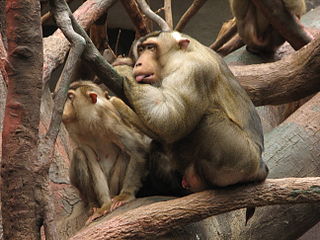
The macaques constitute a genus (Macaca) of gregarious Old World monkeys of the subfamily Cercopithecinae. The 23 species of macaques inhabit ranges throughout Asia, North Africa, and Gibraltar. Macaques are principally frugivorous, although their diet also includes seeds, leaves, flowers, and tree bark. Some species, such as the crab-eating macaque, subsist on a diet of invertebrates and occasionally small vertebrates. On average, southern pig-tailed macaques in Malaysia eat about 70 large rats each per year. All macaque social groups are matriarchal, arranged around dominant females.

The crab-eating macaque, also known as the long-tailed macaque and referred to as the cynomolgus monkey in laboratories, is a cercopithecine primate native to Southeast Asia. A species of macaque, the crab-eating macaque has a long history alongside humans. The species has been alternately seen as an agricultural pest, a sacred animal, and, more recently, the subject of medical experiments.

The Barbary macaque, also known as Barbary ape or magot, is a macaque species native to the Atlas Mountains of Algeria and Morocco, along with a small introduced population in Gibraltar.

The lion-tailed macaque, also known as the wanderoo, is an Old World monkey endemic to the Western Ghats of South India.

The Assam macaque or Assamese macaque is a macaque of the Old World monkey family native to South and Southeast Asia. Since 2008, the species has been listed as "near threatened" by the IUCN, as it is experiencing significant declines due to hunting, habitat degradation, and fragmentation.

The bonnet macaque, also known as zati, is a species of macaque endemic to southern India. Its distribution is limited by the Indian Ocean on three sides and the Godavari and Tapti Rivers, along with its related competitor the rhesus macaque in the north. Land use changes in the last few decades have resulted in changes in its distribution boundaries with the rhesus macaque, raising concern for its status in the wild.

The stump-tailed macaque, also called the bear macaque, is a species of macaque native to South Asia and Southeast Asia. In India, it occurs south of the Brahmaputra River, in the northeastern part of the country. Its range in India extends from Assam and Meghalaya to eastern Arunachal Pradesh, Nagaland, Manipur, Mizoram and Tripura.
Nokrek National Park, the core area of Nokrek Biosphere Reserve, is a national park located approximately 2 km away from Tura Peak in West Garo Hills district of Meghalaya, India. UNESCO added the Nokrek Biosphere Reserve to its list of Biosphere Reserves in May 2009. Along with the Balpakram National Park in South Garo Hills, Nokrek is a hotspot of biodiversity in Meghalaya. Established in 1986, the National Park area comprising around 47.48 square kilometres is looked after by the Northern Nokrek and the Southern Nokrek Ranges of the Meghalaya State Forest Department under the administrative control of the Government of Meghalaya, India.

The Pagai Island macaque, also known as the Pagai macaque or Bokkoi, is an Old World monkey endemic to the Mentawai Islands off the west coast of Sumatra. It is listed as critically endangered on the IUCN Red List due to its ever-shrinking habitat. Macaca pagensis formerly included the overall darker Siberut macaque as a subspecies, but this arrangement is polyphyletic, leading to the two being classified as separate species. Both were formerly considered subspecies of the southern pig-tailed macaque.

The southern pig-tailed macaque, also known as the Sundaland pig-tailed macaque and Sunda pig-tailed macaque, is a medium-sized macaque that lives in southern Thailand, Malaysia, and Indonesia. It is known locally as berok.

The Northern Indochina subtropical moist forests are a subtropical moist broadleaf forest ecoregion of northern Indochina, covering portions of Vietnam, Laos, Thailand, Myanmar, and China's Yunnan Province.

The northern pig-tailed macaque is a species of macaque in the family Cercopithecidae. It is found in Bangladesh, Cambodia, China, India, Laos, Myanmar, Thailand, and Vietnam. Traditionally, M. leonina was considered a subspecies of the southern pig-tailed macaque, but is now classified as individual species.

The Siberut macaque is a vulnerable species of macaque, which is endemic to Siberut Island in Indonesia. It was formerly considered conspecific with the Pagai Island macaque which is overall paler in color, but this arrangement was polyphyletic. Both were formerly considered subspecies of the southern pig-tailed macaque.
Balpakram is located in South Garo Hills district in Meghalaya, India.
Plasmodium fieldi is a parasite of the genus Plasmodium sub genus Plasmodium found in Malaysia. This species is related to Plasmodium ovale and Plasmodium simiovale. As in all Plasmodium species, P. fieldi has both vertebrate and insect hosts. The vertebrate hosts for this parasite are primates.

The Philippine long-tailed macaque is a subspecies of the crab-eating macaque, known in various Philippine languages as matching/matsing or the more general term unggoy ("monkey"). It is endemic to the Philippine forests and woodlands, but especially in the mangrove forests of western central Philippines— particularly in Palawan, the Visayas, and Mindanao. The names M. f. philippinensis and M. f. philippinenesis have also been used, but arise from orthographical error.











